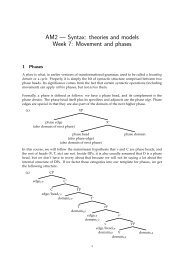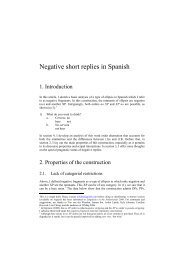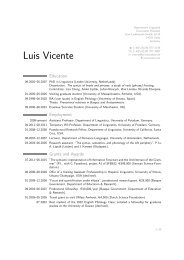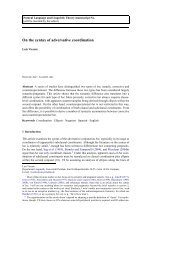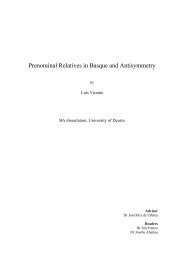Verb fronting in Mandarin Chinese - Luis Vicente
Verb fronting in Mandarin Chinese - Luis Vicente
Verb fronting in Mandarin Chinese - Luis Vicente
Create successful ePaper yourself
Turn your PDF publications into a flip-book with our unique Google optimized e-Paper software.
Cheng & <strong>Vicente</strong><br />
<strong>Verb</strong> <strong>front<strong>in</strong>g</strong> <strong>in</strong> Mandar<strong>in</strong><br />
UCSC L<strong>in</strong>guistics Colloquium<br />
October 31, 2008<br />
b. ta lian zhe-be shu dou kan-le (*zhe-be shu)<br />
he lian this.cl book dou read.asp this.cl book<br />
“He read even this book”<br />
Although verb-<strong>front<strong>in</strong>g</strong>-plus-doubl<strong>in</strong>g constructions do not exist <strong>in</strong> (Standard) English, they are extremely<br />
common crossl<strong>in</strong>guistically, and they are usually referred to as predicate clefts.<br />
(6) Some languages with predicate clefts (mostly from Kandybowicz 2006)<br />
Akan, Basque, Brazilian Portuguese, Brazilian Sign Language, Bulì, Capeverdean, Caribbean<br />
English Creole, Ch<strong>in</strong>ese, Edo, Eŵe, Fongbe, French, Guadeloupe, Gullah, Gungbe, Haitian<br />
Creole, Hausa, Hebrew, Hungarian, Igbo, Île de France Creole, Jamaican, Japanese, Korean,<br />
Krio, Mauritian Creole, Negerhollands, Nupe, Nweh, Papiamentu, Rodrigues Island Creole,<br />
Russian, Saramacan, Seselwa, Spanish, Sranan, Tr<strong>in</strong>idad Dialect English, Turkish, Twi, Vata,<br />
Yiddish, Yoruba.<br />
(7) Comer, pro he comido<br />
eat.<strong>in</strong>f I have eaten<br />
“As for eat<strong>in</strong>g, I have <strong>in</strong>deed eaten” [Spanish, <strong>Vicente</strong> 2007]<br />
(8) Olvasni, olvasta János egy könyvet<br />
read.<strong>in</strong>f, read.pst.3sg János a book.acc<br />
“As for read<strong>in</strong>g, János has <strong>in</strong>deed read a book” [Hungarian, <strong>Vicente</strong> 2007]<br />
Normally, predicate clefts give rise to a verum focus read<strong>in</strong>g (focus on the truth of the proposition),<br />
though this is not always the case –e.g., <strong>in</strong> French, they create a high degree/surprise read<strong>in</strong>g.<br />
(9) Pour manger des pommes, Laurent a mangé des pommes<br />
for eat.<strong>in</strong>f of.the apples Laurent has eaten of.the apples<br />
“As for eat<strong>in</strong>g apples, look at how many Laurent has eaten!”<br />
[French, J. Rooryck p.c.]<br />
In all languages, the lower <strong>in</strong>stance of the verb appears <strong>in</strong>flected as appropriate. As for the upper copy,<br />
it tends to be realized as an <strong>in</strong>f<strong>in</strong>itive/bare verb form <strong>in</strong> European and Asian languages (<strong>in</strong>clud<strong>in</strong>g<br />
Ch<strong>in</strong>ese). On the other hand, African and Creole languages tend to realize it as a nom<strong>in</strong>alized verb.<br />
(10) a. (ká) dĒ-kā àlī Àtìm dĒ mángò-kǔ dīem<br />
foc eat.nomlzr comp Atìm eat mango.det yesterday<br />
“It is eat<strong>in</strong>g that Àtìm did with the mango yesterday” [Bulì, Hiraiwa 2005]<br />
b. Bi-ba Musa à ba nakàn o<br />
redup-cut Musa fut cut meat foc<br />
“It is cutt<strong>in</strong>g that Musa will do to the meat” [Nupe, Kandybowicz 2006]<br />
The syntactic properties of predicate clefts are also very well-def<strong>in</strong>ed:<br />
• In many languages, the relation between the two verbs is one of movement (exceptions: Yiddish,<br />
various idiolects of Spanish and Brazilian Portuguese).<br />
• Movement targets a constituent <strong>in</strong> the extended VP area, though the exact projection may vary<br />
among languages.<br />
• Double pronunciation is a last-resort strategy to salvage an otherwise deviant structure.<br />
2 of 13



